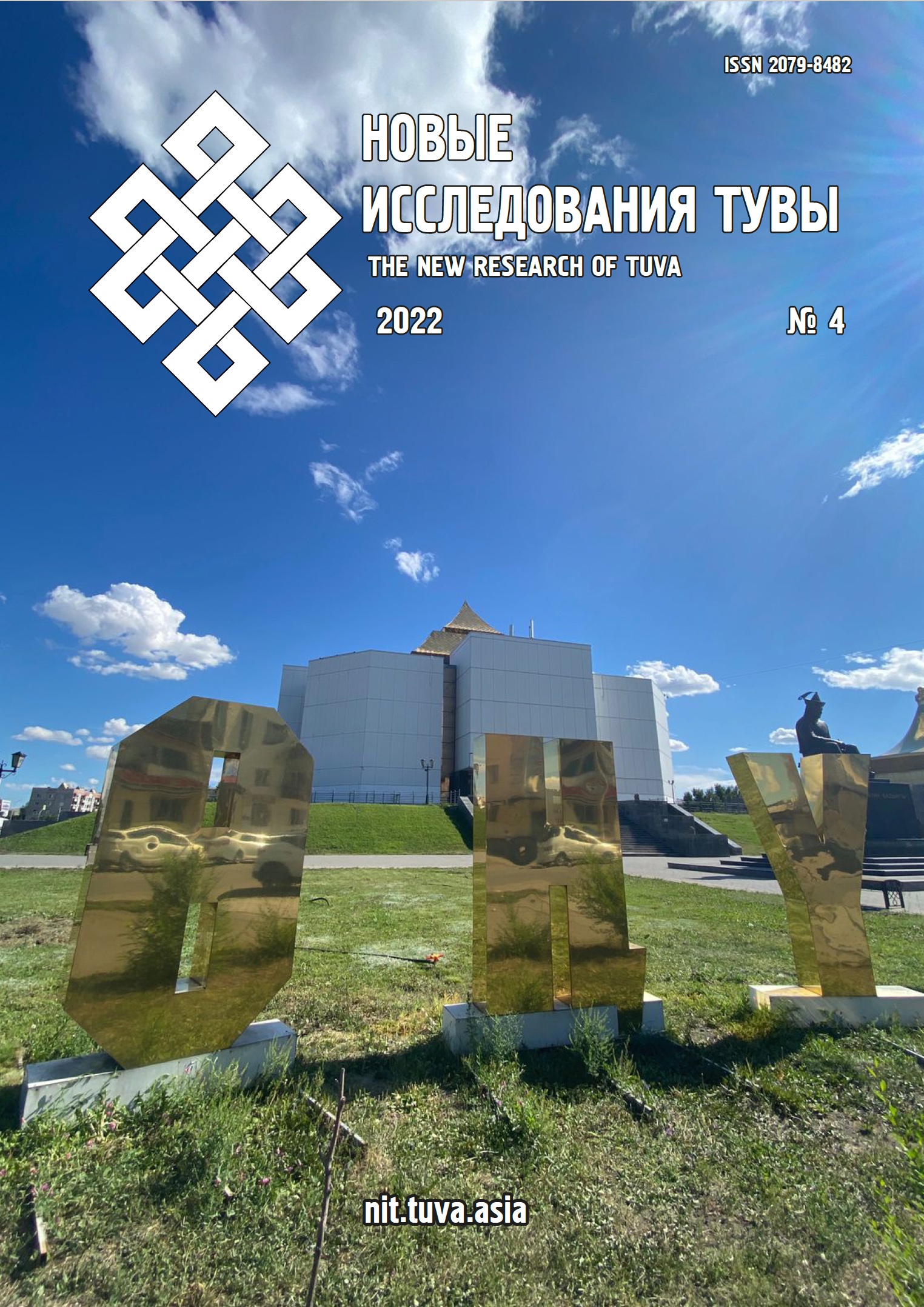Numerical code of Tuvan linguistic culture in proverbs (as contrasted to a number of Turkic and Mongolian languages of the peoples of Russia)
DOI:
https://doi.org/10.25178/nit.2022.4.20Keywords:
cultural code; paremia; proverb; Tuvan language; Tuvan folklore; cultural transfer; symbolism of numbers; numerical component; numerical codeAbstract
The article analyzes Tuvan paremias with the numerical component “one”, “two”, “three”, retrieved from various lexicographic sources by unselected sampling, and compares them with proverbs in the Khakas, Altai, Kumyk, Kalmyk and Buryat languages. In our work, we used the methods of historical and etymological, descriptive and analytical, linguistic and culturological analysis as well as the method of structural and semantic modeling. This made it possible to draw an interlanguage comparison of paremiological units in the aspect of comparative linguoaxiology and ethnolinguoculturology.
It has been found out that the paremiological units of the Tuvan linguistic culture are mostly based on symbolic and sacred semantics of numbers. They feature popular beliefs, rituals, folklore and mythological images. The same is typical for the paremiological fund of languages considered alongside. It is noted that there is a significant number of common points in the symbolism of the numbers of the Turkic and Mongolian paremias. This is due to both the universal panhuman character of numerical symbolism and the kinship of these languages included in the Altai linguistic macrofamily. It can also be explained using the theory of cultural and linguistic transfer.
References
Babueva, V. D. (2001) Mir traditsii buriat [The world of Buryat traditions]. Ulan-Ude, Ulzy. 144 p. (In Russ.).
Boktaeva, V. L., Khalgaeva, D. D. and Bezrukova, O. G. (2017) Simmetriia v mental'nosti russkogo i kalmytskogo narodov v poslovitsakh i pogovorkakh [Symmetry in the mentality of the Russian and Kalmyk peoples in proverbs and sayings]. In: Innovatsionnye tekhnologii v obrazovanii i nauke [Innovative technologies in education and science] : Proceedings of the 2nd International science-to-practice conference (Cheboksary, September 10, 2017) / editorial board: O. N. Shirokov et al. Cheboksary, TsNS “Interaktiv plius”. 420 p. Pp. 325–328. (In Russ.).
Bredis, M. A. and Ivanov, E. E. (2022) Proverbial'nye faktory perevoda tuvinskikh poslovits v aspekte normativnoi i polilingval'noi paremiografii (na fone russkogo i angliiskogo iazykov) [Proverbial factors in translating Tuvan proverbs in the light of normative and poly-lingual paremiography (as contrasted to Russian and English languages)]. New Research of Tuva, no. 1, pp. 17–36. (In Russ.). DOI: https://doi.org/10.25178/nit.2022.1.2
Bredis, M. A., Ivanov, E. E., Lomakina, O. V., Nelyubova, N. Yu. and Kuzhuget, Sh. Yu. (2021) Leksikograficheskoe opisanie tuvinskikh poslovits: printsipy, struktura, etnolingvokul’turologicheskii kommentarii (na evropeiskom paremiologicheskom fone) [A lexicographical description of Tuvan proverbs: Principles, structure and an ethnolinguoculturological commentary as compared to European paremies]. New Research of Tuva, no. 4, pp. 143–160. (In Russ.). DOI: https://doi.org/10.25178/nit.2021.4.11
Bredis, M. A. and Lomakina, O. V. (2020) Pogranichnye territorii kak primer kul'turno-iazykovogo transfera (na materiale latgal'skoi i rusinskoi paremiologii) [Border territories as an example of cultural and linguistic transfer (based on the material of Latgalian and Rusin paremiology)]. Voprosy etnopolitiki, no. 2, pp. 28–38. (In Russ.). DOI: https://doi.org/10.28995/2658-7041-2020-2-28-38
Bredis, M. A., Dimoglo, M. S. and Lomakina, O. V. (2020) Paremii v sovremennoi lingvistike: podkhody k izucheniiu, tekstoobrazuiushchii i lingvokul'turologicheskii potentsial [Paremias in modern linguistics: Approaches to study, text-forming and linguocultural potential]. RUDN Journal of Language Studies, Semiotics and Semantics, vol. 11, no. 2, pp. 265–284. (In Russ.). DOI: https://doi.org/10.22363/2313-2299-2020-11-2-265-284
Bredis, M. A., Lomakina, O. V. and Mokienko, V. M. (2020) Rusinskaia frazeologiia kak primer kul'turno-iazykovogo transfera v slavianskikh iazykakh (na materiale numerativnykh edinits) [Rusin phraseology as an example of cultural and linguistic transfer in Slavic languages (based on numerative units)]. Rusin, no. 60, pp. 198–212. (In Russ.). DOI: https://doi.org/10.17223/18572685/60/12
Bredis, M. A., Lomakina, O. V. and Mokienko, V. M. (2021) Chislovoi kod rusinskoi kul'tury (na frazeologicheskom materiale) [Numeric code of the Rusin languaculture (based on figurative units)]. Kognitivnye issledovaniia iazyka, no. 2 (45), pp. 202–212. (In Russ.).
Garmaeva, A. E. (2008) Chislovaia simvolika v mongol'skom iazyke: semantika i funktsii [Numerical symbolism in the Mongolian language: Semantics and functions]. Vestnik Buriatskogo gosudarstvennogo universiteta, no. 10, pp. 105–110. (In Russ.).
Gishkaeva, L. N., Lomakina, O. V. and Makarova, A. S. (2021) Otrazhenie very v Boga kak tsennostnoi konstanty v poslovichnom fonde (na primere khristianskoi i musul'manskoi lingvokul'tur) [Reflection of faith in God as a value constant in the proverbial fund (on the example of Christian and Muslim linguistic cultures)]. Cuadernos de Rusística Española, vol. 17, pp. 135–147. (In Russ.).
Gudkov, D. B. and Kovshova, M. L. (2007) Telesnyi kod russkoi kul'tury: materialy k slovariu [The body code of Russian culture: Materials for the dictionary]. Moscow, Gnozis. 285 p. (In Russ.).
Zhukovskaia N. L. (2002) Kochevniki Mongolii: Kul'tura. Traditsii. Simvolika [Nomads of Mongolia: Culture. Traditions. Symbolism]. Moscow, Vostochnaia literatura. 247 p. (In Russ.).
Zinovieva, E. I. and Alyoshin, A. S. (2022) Sem'ia v komparativnykh paremiiakh tuvinskogo, shvedskogo i russkogo iazykov [The family in comparative paremies of Tuvan, Swedish and Russian languages]. New Research of Tuva, no. 1, pp. 131–145. (In Russ.) DOI: https://doi.org/10.25178/nit.2022.1.9
Ivanov, E. E., Lomakina, O. V. and Nelyubova, N. Yu. (2021) Semanticheskii analiz tuvinskikh poslovits: modeli, obrazy, poniatiia (na evropeiskom paremiologicheskom fone) [Semantic analysis of Tuvan proverbs: Models, imagery, concepts (against the European paremiological background)]. New Research of Tuva, no. 3, pp. 232–248. (In Russ.). DOI: https://doi.org/10.25178/nit.2021.3.17
Ivanov, E. E., Lomakina, O. V. and Petrushevskaia, Yu. A. (2021) Natsional'naia spetsifichnost' poslovichnogo fonda: osnovnye poniatiia i metodika vyiavleniia [The national specificity of the proverbial fund: Basic concepts and procedure for determining]. RUDN Journal of Language Studies, Semiotics and Semantics, vol. 12, no. 4, pp. 996–1035. (In Russ.). DOI: https://doi.org/10.22363/2313-2299-2021-12-4-996-1035
Ivanov, E. E., Marfina, Zh. V. and Shkuran, O. V. (2022) Nominatsii zhivotnykh v tuvinskikh poslovitsakh i pogovorkakh: aspekty realizatsii i problematika izucheniia [Animal nouns in Tuvan proverbs and sayings: Problems of studying and aspects of functioning]. New Research of Tuva, no. 1, pp. 47–68. (In Russ.). DOI: https://doi.org/10.25178/nit.2022.1.4
Karataeva, S. T. (2020) Simvolika chisel v tiurkskikh i mongol'skikh iazykakh [Symbolic chips in Turkic and Mongolian languages]. Vestnik Kyrgyzskogo gosudarstvennogo universiteta imeni I. Arabaeva, no. 2, pp. 91–97. (In Russ.).
Kulsarina, G. G. (2016) Etnokul'turnaia simvolika chisel v iazyke bashkirskogo fol'klora [Ethnocultural symbolism of numbers in the language of Bashkir folklore]. Filologicheskie nauki. Voprosy teorii i praktiki, no. 10 (64), part 1, pp. 106–109. (In Russ.).
Kurbatskii, G. N. (2001) Tuvintsy v svoem fol'klore (istoriko-etnograficheskie aspekty tuvinskogo fol'klora) [Tuvans in their folklore: Historical and ethnographic aspects of Tuvan folklore)]. Kyzyl, Tuvan Book Publishing house. 464 p. (In Russ.).
Lomakina, O. V. and Mokienko, V. M. (2018) Tsennostnye konstanty rusinskoi paremiologii (na fone ukrainskogo i russkogo iazykov) [Value constants of the Rusin paremiology (compared with the Ukrainian and Russian languages)]. Rusin, no. 4 (54), pp. 303–317. (In Russ.). DOI: https://doi.org/10.17223/18572685/54/18
Liashchynskaia, V. A. (2019) Іdyiamatyka belaruskai movy ў lіngvakul'turalagіchnym asviatlennі [Idiomatics of the Belarusian language in linguoculturological coverage]. Mіnsk, RІVSh. 250 p. (In Belarusian).
Mizhit, L. S. (2013) Tuvinskoe trekhstishie. Triada v tuvinskoi traditsionnoi kul'ture [Tuva tercet: The Triad in Tuvan traditional culture]. Novosibirsk, Publishing House of the Siberian Branch of the RAS. 138 p. (In Russ.).
Mokienko, V. M. (2010) Sovremennaia paremiologiia (lingvisticheskii aspekt) [Modern paremiology (linguistic aspect)]. Mir russkogo slova, no. 3, pp. 6–20. (In Russ.).
Muitueva, I. N., Oinoshev, V. P. and Tadysheva, N. O. (2018) Altaiskii traditsionnyi etiket [Altai traditional etiquette]. Gorno-Altaisk, S. S. Surazakov Scientific Research Institute of Altaic Studies. 160 p. (In Russ.).
Muratova, R. T. (2012) Simvolika chisel v iazyke i kul'ture bashkir [Symbolism of numbers in the Bashkir language and culture]. Ufa, s. n. 180 p. (In Russ.).
Muratova, R. T. (2015) Numerologicheskie frazeologicheskie edinitsy v tiurkskikh iazykakh (lingvokul'turologicheskii aspekt) [Numerological phraseological units in the Turkic languages (linguoculturological aspect)]. Vestnik Adygeiskogo gosudarstvennogo universiteta, issue 1 (152), pp. 71–77. (In Russ.).
Neliubova, N. Yu. (2019) Sem'ia kak obshchechelovecheskaia tsennost' vo frantsuzskoi i russkoi poslovichnoi kartine mira [The family as a universal value in the French and Russian proverbial picture of the world]. Filologicheskie nauki. Nauchnye doklady vysshei shkoly, no. 6, pp. 50–59. (In Russ.). DOI: https://doi.org/10.20339/PhS.6-19.050
Neliubova, N. Yu. (2022) Aksiologicheskie dominanty paremii kak tipologicheskie markery tuvinskoi, russkoi i frantsuzskoi etnokul'tur [Axiological dominants of paremies as typological markers in Russian, Tuvan and French ethnic cultures]. New Research of Tuva, no. 1, pp. 146–163 (In Russ.). DOI: https://doi.org/10.25178/nit.2022.1.10
Nikitina, T. G. (2020) Strukturno-semanticheskoe modelirovanie v sfere frazeologii: sorokaletnii opyt i perspektivy [Structural-semantic modeling in phraseology: Forty years of experience and the prospects]. RUDN Journal of Language Studies, Semiotics and Semantics, vol. 11, no. 2, pp. 175–197. (In Russ.). DOI: https://doi.org/10.22363/2313-2299-2020-11-2-175-197
Oinotkinova, N. R. (2012) Altaiskie poslovitsy i pogovorki: poetika i pragmatika zhanrov [Altai proverbs and sayings: Poetics and pragmatics of genres]. Novosibirsk, Institute of Philology. 354 p. (In Russ.).
Paremiologiia bez granits [Paremiology without borders] (2020) / ed. by M. A. Bredis and O. V. Lomakina. Moscow, RUDN Publ. 244 p. (In Russ.).
Paremiologiia v diskurse [Paremiology in discourse] (2015) / ed. by O. V. Lomakina. Moscow, URSS ; Lenand. 294 p. (In Russ.).
Paremiologiia na perekrestkakh iazykov i kul'tur [Paremiology at the crossroads of languages and cultures] (2021) / ed. by E. E. Ivanov and O. V. Lomakina. Moscow, RUDN Publ. 246 p. (In Russ.).
Petrushevskaya, J. A. (2022) Tuvinskie i belorusskie poslovichnye paralleli (tipologicheskaia obshchnost’ na fone etnokul’turnoi spetsifichnosti) [Tuvan and Belarusian proverbial parallels (typological community amid ethnocultural specificity)]. New Research of Tuva, no. 3, pp. 241–263. (In Russ.). DOI: https://doi.org/10.25178/nit.2022.3.16
Rassadin, V. I. (2019) Ocherki po istorii slozheniia tiurko-mongol'skoi iazykovoi obshchnosti [Essays on the history of the formation of the Turkic-Mongolian language community]. St. Petersburg, Nestor-Istoriia. 620 p. (In Russ.).
Russkie paremii: novye formy, novye smysly, novye aspekty izucheniia [Russian paremias: New forms, new meanings, new aspects of study] (2008) / ed. by T. G. Nikitin. Pskov, Pskov State Pedagogical University. 256 p. (In Russ.).
Samdan, Z. B. (1994) Mir tuvinskoi skazki [The world of the Tuvan folk tale]. In: Tuvinskie narodnye skazki [Tuvan folk tales] / comp. by Z. B. Samdan. Novosibirsk, Nauka, Sibirskaia izdatel'skaia firma. 460 p. Pp. 10–34. (In Russ.).
Samdan, Z. B. (2016) Mif v fol'klornoi traditsii tuvintsev: formy bytovaniya, syuzhetnyi sostav, sistema personazhei [Myth in Tuvan folklore traditions: The form of existence, the scene composition, system of characters]. Novosibirsk, Nauka. 180 p. (In Russ.).
Semenenko, N. N. (2020) Aksiologiia paremii v fokuse problemy kognitivno-diskursivnogo modelirovaniia semantiki russkikh poslovits [Axiology of proverbs in the focus of the problem of cognitive-discursive modeling of semantics of Russian proverbs]. RUDN Journal of Language Studies, Semiotics and Semantics, vol. 11, no. 2, pp. 213–232. (In Russ.). DOI: https://doi.org/10.22363/2313-2299-2020-11-2-213-232
Sravnitel'no-istoricheskaia grammatika tiurkskikh iazykov. Leksika [A comparative historical grammar of Turkic languages. Vocabulary] (2001) / E. R. Tenishev, G. F. Blagova, I. G. Dobrodomov et al. ; ed. by E. R. Tenishev. 2nd ed, enlarged. Moscow, Nauka Publ. 822 p. (In Russ.).
Tagarova, T. B. (2011) K lingvokul'turologicheskomu opisaniiu buriatskikh frazeologicheskikh edinits s chislitel'nymi [To the linguoculturological description of Buryat phraseological units with numerals]. Uchenye zapiski Zabaikal'skogo gosudarstvennogo gumanitarno-pedagogicheskogo universiteta im. N. G. Chernyshevskogo. Seriia: Filologiia, istoriia, vostokovedenie, no. 2 (37), pp. 112–117. (In Russ.).
Tenishev, E. R. (1978) Tiurkskie «odin», «dva», «tri» [Turkic “one”, “two”, “three”]. In: Tiurkologicheskii sbornik. 1974 [Turkological collection. 1974] / editorial board: A. N. Kononov (executive ed.), S. G. Kliashtornyi, Yu. A. Petrosian and S. S. Tselniker. Moscow, Nauka, Glavnaia redaktsiia vostochnoi literatury. 304 p. Pp. 109–113. (In Russ.).
Ivanov, E. (2002) Paremiological minimum and basic paremiological stock (Belarusian and Russian). Prague, RSS. 136 p.
Ivanov, E. and Feldman, V. (2007) Principles of the contrastive description of aphoristic paremiology (in Belarusian and Russian languages). Acta Germano-Slavica, vol. 1, pp. 85–97.
Ivanov, E. and Petrushevskaia, Ju. (2015) Etymology of English proverbs. Journal of Siberian Federal University. Humanities & Social Sciences, vol. 8, no. 5, pp. 864–872.
Lomakina, O. V. (2021) Concepts of god and faith in Uzbek and Tajik proverbs in terms of culture and language transfer theory. European Journal of Science and Theology, vol. 17, no. 2, pp. 125–135.
Seliverstova, E. I. (2020) Levels of manifestation of typological similarity in proverbs of different languages. RUDN Journal of Language Studies, Semiotics and Semantics, vol. 11, no. 2, pp. 198–212. DOI: https://doi.org/10.22363/2313-2299-2020-11-2-198-212
Published
How to Cite
For citation:
Bredis M. A., Lomakina O. V., Borisova A. S. and Lazareva O. V. Chislovoi kod tuvinskoi lingvokul’tury v poslovitsakh (na fone riada tiurkskikh i mongol’skikh iazykov narodov Rossii) [Numerical code of Tuvan linguistic culture in proverbs (as contrasted to a number of Turkic and Mongolian languages of the peoples of Russia)]. New Research of Tuva, 2022, no. 4, pp. 276-293 (In Russ.). DOI: https://www.doi.org/10.25178/nit.2022.4.20
Issue
Section

This work is licensed under a Creative Commons Attribution-NonCommercial 4.0 International License.

Author(s) license holder(s) grant rights for their work to the journal (grantee of a license) under the simple non-exclusive open license in accordance with Art. 1286.1 «Open license for a research work, work of literature or fine arts», Civil Code of the Russian Federation.
New Research of Tuva publishes articles under the Creative Commons Attribution-NonCommercial license (CC BY-NC).
Since it is an open license, author(s) reserve the right to upload the article to their institutional repository, submit it to another journal (if it allows republications), or republish it on their own website (in full, or in part).
However, several conditions apply here:
a) The republished version must always contain the name(s) and affiliation(s) of the author(s), the original title and the hyperlink to the original version on the New Research of Tuva website;
b) It must be in open access, free of charge, and no category of readers must be in any way whatsoever advantaged over general readership.
c) should the contribution be submitted elsewhere by its author(s) without substantial modification (30% or more of original text unchanged), the body of the article should contain a disclaimer that the original version was published in New Research of Tuva (with a link to the respective page)
The CC-BY-NC is a non-revocable license which applies worldwide and lasts for the duration of the work’s copyright.












